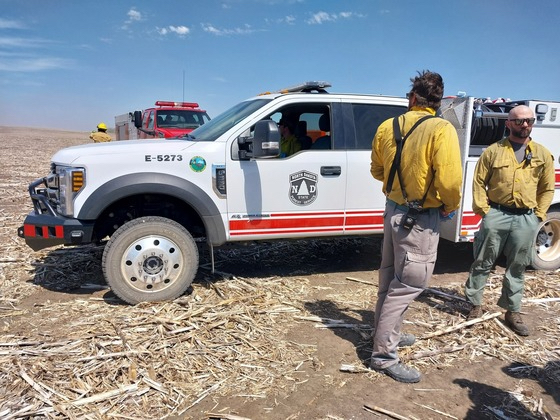Multiple wildfires break out across state over weekend

Submitted Photo Responders are shown at a field fire near McClusky Saturday. Photo by Seth Galvin with Goodrich Rural Fire Department.
BISMARCK – North Dakota firefighters fought numerous blazes over the weekend as Red Flag Warnings have been persistent due to dry and windy conditions across much of the state.
Engines and firefighters from the North Dakota Wildland Task Force, North Dakota Forest Service and a team from Colorado were staged throughout the state over the weekend to quickly respond and reinforce local firefighters as fires popped up, according to the North Dakota Department of Emergency Services (DES).
Twenty fires broke out on Sunday alone, DES reported. The North Dakota Watch Center, a 24-hour monitoring and notification center within DES, was notified of two fires in each Sargent, Morton LaMoure and McKenzie counties and the Spirit Lake Reservation. Additional fires were reported in Slope, Hettinger, Dickey, Logan County, Adams, Dunn, Ward, Rolette and Kidder counties and the Turtle Mountain Reservation.
In total, 60 fire starts were reported over the weekend, burning more than 1,100 new acres in addition to the acres burning in the ongoing Turtle Mountain fire complex, DES reported.
Significant fires include one northeast of Glen Ullin in Morton County that burned 500 acres. A field fire northeast of McClusky in Sheridan County burned one tractor and 125 acres. Response included local, state, and out-of-state response. A fire southwest of Sherwood in Renville County on Saturday burned one outbuilding and called in four local fire departments. These are all considered inactive currently.
Two grass fires broke out in the ongoing fire complex in the Turtle Mountain area. The total acreage estimate remains at 3,600 acres. The fire is still active and is anticipated to be a long-lived event, according to DES information.
“We can tell the public is hyper-aware of the threat of wildfires and is helping to do their part in avoiding burning and notifying emergency responders of smoke. Thank you. Every fire we don’t start is one that our firefighters don’t have to go fight, putting themselves in danger,” Darin Hanson, director of Homeland Security within DES, said in a news release. “We all need to keep working together to prevent wildfires and support our first responders.”
Fire Danger Ratings are calculated using inputs such as long-term climate information, short-term weather patterns and indicators such as relative humidity, temperature, wind speed and fuel conditions on the ground (how dry the grasses are, for example).
The fire danger ratings are indicative of the threat of fire growth, not necessarily the threat of fire starts. Should a fire ignite, it is more likely that it will spread rapidly during higher fire danger rating days.



